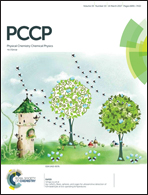Absorption behavior of poly(methyl methacrylate)–multiwalled carbon nanotube composites: effects of UV irradiation†
Abstract
Understanding the effects of carbon nanotubes (CNTs) and ultraviolet (UV) irradiation on solvent transport in polymers is of practical importance for the applications of polymer–CNT composites in electronics and photonics. The transport behavior of methanol in poly(methyl methacrylate)–multiwalled carbon nanotube (PMMA–MWCNT) composites with and without UV light irradiation has been studied. The anomalous transport has been investigated as a function of the weight percentage of MWCNTs and UV dose in the temperature range of 30–50 °C. The anomalous transport consists of Case I (controlled by concentration gradient) and Case II (controlled by stress relaxation) transport; both UV irradiation and the addition of MWCNTs in PMMA enhance the transport of methanol. The activation energies for Case I and Case II transport decrease with the increase of UV dose for the PMMA–MWCNT plates with the same weight percentage of MWCNTs. Without UV irradiation, the activation energy for Case I transport of methanol decreases with the increase of the weight percentage of MWCNTs, and the activation energy for Case II transport increases with the increase of the weight percentage of MWCNTs.



 Please wait while we load your content...
Please wait while we load your content...